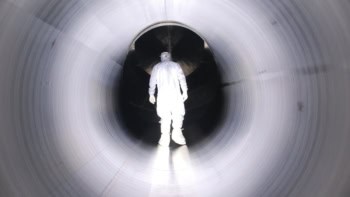From zero to 200 MeV in less than a millimetre in a wake-field accelerator
Particle accelerators are the largest pieces of equipment that physicists have to help them unravel nature’s secrets. Take the 27 km circumference of the Large Hadron Collider under construction at CERN in Geneva or the 3 km linear accelerator at the Stanford Linear Accelerator Center in the US. These machines accelerate particles to energies above 1010 eV and then collide them to explore fundamental questions in high-energy physics.
However, as successful as they are in tackling problems such as the origin of mass and the asymmetry between matter and antimatter, accelerators cannot keep achieving higher and higher energies. Most accelerators use radio-frequency waves confined in metallic cavities to give particles a “kick” in energy each time they pass through the cavity. However, the acceleration gradients that these machines can achieve are limited, and the only way to reach higher energies is to build bigger accelerators with more cavities.
Wake-field accelerators
However, an exciting alternative method of acceleration is making great strides towards the next energy regime. The “laser wake field” accelerator relies on exploiting the radiation pressure of an intense laser pulse to displace the electrons in a plasma, leaving a large electric field in its wake (figure 1). Now Viktor Malka of the Ecole Polytechnique in France and colleagues from the CEA/DAM laboratory in Bruyères-le-Châtel, the University of Bordeaux and Imperial College in the UK have demonstrated that electrons can be rapidly accelerated by surfing such a wake (V Malka et al. 2002 Science 298 1596).
Their results show that an electron at rest can be accelerated to an energy of 200 MeV in a distance of just 1 mm. This is a terrestrial particle-acceleration record, although similar plasma-acceleration processes may occur with even greater ferocity in the astrophysical plasmas that surround supernovae and black holes. At rates like this, the current high-energy frontier could be reached in an accelerator only one metre long!
But there is a catch. In addition to reaching high energies, the accelerator must also produce a beam of high quality if it is to be of use in physics applications. This means that the beam must be well collimated, it must contain a large number of particles and all the particles must have the same (or almost the same) energy. There is still a long way to go to realize all these requirements in a working accelerator, but Malka and co-workers have made a significant step towards achieving two of them. They have accessed a new physical regime of the laser-wake-field accelerator, which has resulted in both the highest energy from such a scheme to date and an improvement in the collimation of the beam. The higher-energy particles were found to emerge in a narrow cone of less than 5° and corresponded to a transverse beam quality that is better than that of a typical conventional linear accelerator.
Surfing the wake
Plasmas make promising particle accelerators because they can support electric fields that are greater than several hundred gigavolts per metre. This is achieved by exciting relativistic plasma waves (spacecharge oscillations, which depend on the density of the plasma) with a high-intensity laser.
There are different types of plasma-based accelerator. In a basic laser-wake-field accelerator, a pulse of photons that is shorter than the plasma wavelength excites a wake, much like the wake produced by a boat (figure 2 top ). This is the simple, or resonant, laser-wake-field regime, which is characterized by clean wakes and its relative freedom from instabilities due to the shortness of the pulse.
This regime, however, has been difficult to access experimentally. As a result, most of the experimental work to date has focused on the longer-pulse regimes. These are the “beat wave” regime in which two lasers beat at the frequency of the plasma wave (figure 2 middle , and the “self-modulated” regime in which a long laser pulse becomes modulated at the plasma frequency due to an instability of the laser in the plasma (figure 2 bottom ).
The latter regimes have been successfully employed by groups from the University of California at Los Angeles, the Naval Research Laboratory, the University of Michigan and the Lawrence Livermore National Laboratory - all in the US - and the Rutherford Appleton Laboratory in the UK to accelerate electrons to roughly 100 MeV.
The high-energy frontier
Simple laser-wake-field acceleration has been out of reach until now due to the laser requirements. The pulse must be short enough to “fit” into half a plasma wavelength but must carry enough energy to drive the oscillating plasma electrons to relativistic speeds. These electrons need to be fast enough so that some of them catch the wake and become trapped and accelerated, like white water cascading down the face of an ocean wave. Using advances in short-pulse power made possible by chirped-pulse-amplification technology, the French group was able to generate a pulse with 1 J of laser energy in 30 fs (30 TW of peak power).
However, even this was not quite short enough to fit into the 10 fs half-wave period of the high-density plasma. Instead, the researchers relied on the plasma itself to reshape and effectively shorten the laser pulse. Several mechanisms contribute to this but the simplest to understand is perhaps the one that arises from the difference in group velocity between the head and the tail of the laser pulse in its own wake. The head travels in the plasma and moves at less than the speed of light, while the tail travels in a plasma depression and so moves at roughly the speed of light in a vacuum. Like a collapsible boat travelling in a water depression, the tail catches up with the head (figure 1). Malka and co-workers refer to this as the “forced” laser-wake-field regime.
As exciting as these results are, they are really just the tip of the iceberg of what laser-wake-field accelerators can do. Malka and co-workers point out a number of exciting applications for their ultrashort (100 fs) bursts of collimated electrons, including the production of short, bright X-ray pulses for biology and crystallography. Researchers around the world are hotly pursuing ideas for extending the interaction length and energy reach of wake-field accelerators, as well as improving other aspects of the beam quality.
Energies of 109 eV cannot be far away and represent another big step towards the high-energy frontier, and beyond.




